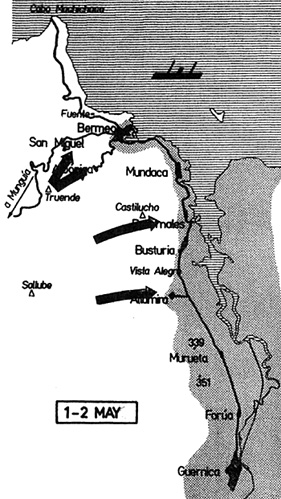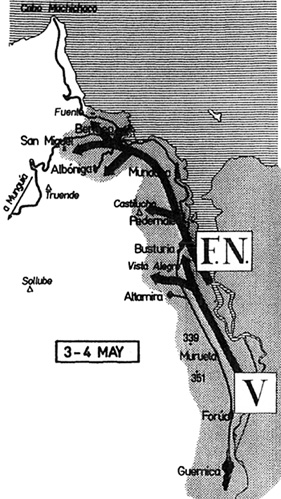Among the military actions taken by General Mola's Nationalist forces before the final assault on Bilbao's "Iron Defence" (Cinturon de Hierro), there were several different skirmish and minor clashes. This article's aim is to cover one of them : the advance on Sollube mountains and the town of Bermeo.
I. If you pay attention to the regional map, you'll see that the Sollube' heights occupy a long line north to south besides a long valley following the river Oca. Such peaks permit full control of the axis Guernica, Forua, Murueta, Altamira, Pedernales, Mundaca and Bermeo, as well as on the long and narrow road connecting these villages.
April 28th 1937, Mola sent orders to General Piazzoni (*1) asking him to build up a defensive line from their actual position in Guernica "with interdiction of the roads Bermeo-Guernica, Munguia-Guernica, and Amorabieta-Guernica". On the 30th, Mola insisted that the "Flechas Negras" commander "not to advance towards north without full control of its left flank, occupied by enemies, or before the advance of IVth Brigade
In spite of such orders, on that date,the 3rd Btn of "Flechas Negras" unit occupied Forua, Murueta, Altamira, Vista Alegre, and some minor peaks around Sollube heights without enemy contact. Under such circumstances, Piazzoni decided to occupy Bermeo with a Flechas Negras Btn. reinforced with an artillery battery, under the command of Major Pozzuoli, sending as well some recon detachments towards Machichaco Cape and Truende peak. The F.N. Btn. arrived that night in Bermeo occupying also Castilucho Peak and without engaging any Republican units. F.N. detachments occupied the tiny island of Chacharrendi at Bermeo Bay and artillery deployed on the beach in case any attacks came from sea.
Mola, who did not have knowledge of such an advance before the end of the next day, had given different orders so that "Flechas Negras Brigade should, once 1st Division had occupied Sollube heights, advance towards the north; and after Bermeo had been reached, advance west". Once he knew what had really happened, Mola sent new orders to Piazzoni to suspend all movements up north until Sollube heights were duly occupied.
Meanwhile, some Republican forces appeared on Truende Peak, over Bermeo, pushing down the "Flechas Negras" inside the town, and occupying the road. The following day (May 2nd), Republican forces (*2,*3) pushed the Italians outside of Mundaca, occupying Castilucho and Vista Alegre Peaks and putting the "Flechas Negras" into an absolutely critical situation. The F.N. Btn. was besieged in Bermeo having lost in their retreat a lot of material, including trucks, two light tanks and nine mortars. According to Italian general Belforte, there was a heroic resistance by the Italians at Bermeo's prison building, suffering 170 casualties.
Two companies from the F.N. "Assault Btn." were urgently sent to reinforce the besieged forces. Piazzoni sent news to Mola, who ordered him to reopen the road Guernica-Bermeo, to fortify and to defend it. The "Francisci Group"(*4) (XXIII Marzo) was also to be sent as reinforcements, but with orders to be used only under extreme situation, and not to be mixed with "Flechas" units. Other Nationalist Spanish units were held outside the situation and under their own commanders with orders not to intervene. Not withstanding those orders, IVth Navarra Brigade tanks were used to reopen the Mundaca road.
Republican "Bous" decided to withdraw at the arrival of "Galerna" a nationalist vessel. Also Nationalist planes bombed the Republican positions at Bermeo's surrounding peaks and heights, to prevent further hostitlities.
On May 3rd, "Flechas Negras" recovered Castilucho Peak and supported by some"XXIII Marzo" forces counterattacked Mundaca and Bermeo surrounding neighbours occupied by Republicans. Finally contact was achieved between besieged Pozzuoli troops and units from 4th Regiment, and Bermeo could be fully reinforced and resupplied.
After the battle, Pozzuoli was promoted, and its Bt. renamed as "Bermeo".
II. The propaganda issued by both sides on the advances and counterattacks that had taken place along the road and Bermeo, show an increased importance of the clash.
Republicans trying to create a second "Guadalajara" (Steer: "The tree..."), with emphasis on Italian losses and prisoners. Nationalist, and mainly Italian sources, insist in the success of the rapid advance (celere) and the heroic resistance at Bermeo against an exaggerated amount of Republican forces.
It must be considered that Republicans were retreating from Guernica, and no tanks seems have been available (may be some "Tiznaos" or light armoured vehicles), and it is difficult to believe that under a withdrawing condition there was time enough to prepare a proper counterattack. On the other side, Nationalist sources insisted to mention a great amount of enemy units to enhance their own final victory.
Weather conditions (heavy rain, mud, etc.) made things quite hard for F.N., who initially had no air support. A very difficult terrain, full of peaks and narrow roads, and the F.N. being surprised (almost an ambush) meanwhile column's advancing along such roads put them in a disordered retreat towards Bermeo, giving the Republicans an excellent position to shoot them from the heights. The Nationalist final victory avoided a proper analysis of the F.N. behaviour acting against orders and their lack of caution, and propaganda needs pushed Franco's headquarters to send a formal congratulation.
Had it been trained or fresh Republican troops who made the counterattack against Bermeo, or had these forces received artillery or air support, the F.N. would have been overrun.
Finally, I've been told some tales from a lady who lived in Mundaca those days,and saw some F.N. running in confusion to Bermeo harbour and beach under heavy rain. Finally, I've been told some tales from a lady who lived in Mundaca during those days, and saw some F.N. running in confusion to Bermeo harbour and beach under heavy rain, caught by the rising tide quickly advancing through the estuary, and drowning or being saved by local civilians. She mentioned that there's a huge memorial plate at Mundaca's cemetery for the Italian casualties.
NOTES
*1 General Piazzoni was commanding "Frecce Nere" Brigade an Italo-Spanish force of 7, 141 soldiers (Spanish 4,849) forming the brigade itself, plus 7 Spanish companies and eight artillery batteries (one Spanish) (J.L. Mesa).
*2. Belforte: Four Btn. reinforced with tanks and supported from the sea by 3 light armed (small calibre guns) "Bous" (fishing boats).
*3 Steer: Two infantry Btn.: one UGT ( A Beevor says this was the 8th UGT battalion ) and one Nationalist Basque. Other sources add a third Basque Btn.
*4 Francisci Group had 7 Banderas (Btn.) 3 batteries 65/17, 2 mortar platoons, 1 carabinieri group and services: 205 officers, 318 n.c.o. and 4,055 italian legionari (J.L. Mesa "El regreso...." pg. 83)
SOURCES
Jose Luis de Mesa. "El regreso de las legiones (Voluntaries italianos en la guerra civil espanola) Garcia Hispan, Editor. S.L. 1994
J. Martinet Bande. "Vizcaya", Monografias de la Guerra Civil espanola. S.H.M. Ed.
San Martin 1971
Generale Francesco Belforte "La campagna dei volontari italiani" vol. 3 Institute per
gli studi di politica internationale. 1939
See also:G.L. Steer: "The Tree of Gernika" Hodder and Stoughton Ltd. London 1938
S. Piazzoni " Las tropas Flechas Negras en la Guerra de Espana" Juventud .1941


Back to Abanderado Vol. 4 No. 1 Table of Contents
Back to Abanderado List of Issues
Back to MagWeb Master Magazine List
© Copyright 1999 by Rolfe Hedges
This article appears in MagWeb (Magazine Web) on the Internet World Wide Web. Other military history articles and gaming articles are available at http://www.magweb.com